Pratt & Whitney Twin Wasp D (R-2000)
Compiled by Kimble D. McCutcheon
Published 2 Jun 2020
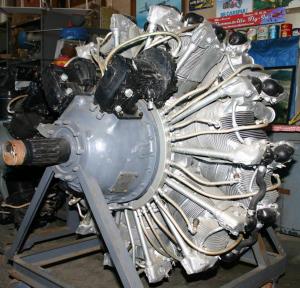
Pratt & Whitney Twin Wasp D
(Bary Brossett) |
The Twin Wasp D was a more powerful version of the R-1830 Twin Wasp, designed primarily for WWII-era U.S. military transports. It was intended to be less costly to manufacture, using plain instead of roller crankshaft main bearings, and easier to maintain, with its two magnetos moved from the rear accessory case to the nose case.
The engine first ran on 21 May 1940 and was first delivered on 7 Aug 1941. Between 1941 and 1949, Pratt & Whitney, and the General Motors Buick Division under license, built 12,966 Twin Wasp D engines.
The Twin Wasp D powered the Cancar CBY-3, de Havilland Canada DHC-4, Douglas Super DC-3, DC-4 and C-54. |
Twin Wasp D Description
Type = 14-cylinder 2-row air-coiled radial
Bore = 5.750" Stroke 5.500" Displacement = 1992.5 in³
Cylinders are built up from cast aluminum heads, with integral valve mechanism housings, screwed and shrunk onto forged steel cylinder barrels. Forged aluminum sleeves in which deep-cut cooling fins have been machined (muffs) are shrunk over the central portion. Each cylinder has one inlet and one exhaust valve, seating on inserts that are shrunk into the head. Pressure baffles are provided.
Forged aluminum pistons feature ribs under the piston crowns for additional coiling. Each piston has three compression rings, one oil scraper ring, and one pair of dual oil control rings.
The master rod cluster consists of the master rod, with detachable cap and two-piece lead-silver bearing. Six "I" section articulated rods are attached by knuckle pins. Each articulated rod has bronze bushings both for the piston and knuckle pin ends.
The crankshaft is a forged steel, two-throw counterweighted, one-piece type, supported by three plain lead-silver bearings in the crankcase section
The crankcase is made up if seven sections. Three parts comprise the power section, and are machined together from aluminum forgings. The magnesium nose section houses reduction gears and has provision for the Hamilton Standard Hydromatic or other full feathering propellers. The power section elements are joined by through bolts. The magnesium blower section, bolted to the power section, contains the supercharger supports the downdraft carburetor and houses the impeller gear train. The accessory section, also of magnesium, is fastened to the blower intermediate section by means of stud bolts,
Exhaust valves are sodium-cooled and faced with stellite. There are two valves per cylinder. The valves are actuated by plain bearing rocker arms and push rods. Two shelf-mounted cams, one in the front power section and one in the rear, are driven directly off the crankshaft by spur reduction gears at one-eighth crankshaft speed. The valve gear is completely enclosed and oil tight.
Induction begins at a Stromberg pressure injection carburetor with automatic mixture control, idle cutoff, primer tubing and distributor. Metered fuel is carried through internal passage and is thrown centrifugally through small holes in a slinger ring mounted on the supercharger impeller drive shaft, Combustion air enters the supercharger at right angles to the screen of vaporized fuel thrown from the slinger ring. The fuel air mixture, after being compressed, collects in the blower rim from where it is carried through intake pipes to individual cylinders, The "washboard" impeller case provides better fuel vaporization and prevents the accumulation and flow of liquid fuel along the wall by returning it to the air stream.
The supercharger is either single-speed or two-speed and is single stage. The impeller is driven by spring-loaded flexible drive gears to absorb shocks and to equalize driving loads, plus cone clutches with creeper desludgers in the case of two-speed drive engines.
The ignition system consists of two nose-mounted Scintilla magnetos, each operating an individual set of spark plugs through a single ignition manifold that is attached to the power section front . The magnetos, manifold and spark plug leads are radio-shielded.
Forced lubrication to all parts of the engine is provided by a gear-type oil pump.
The planetary reduction gears are of Pratt & Whitney design and have a reduction ratio of 0.50:1. The propeller shaft is supported at the crankshaft end in two concentric bearings mounted in a support plate at the rear of the nose housing and at the front of the nose section by a deep groove ball bearing that absorbs the engine thrust. The propeller shaft is completely decoupled from the crankshaft.
All accessories are grouped in the rear and are driven through intermediate gear trains by a single driveshaft spline fitted to the crankshaft rear.
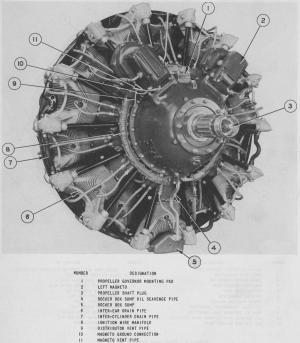 |
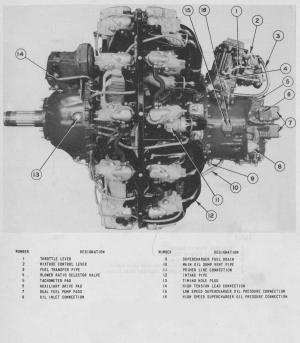 |
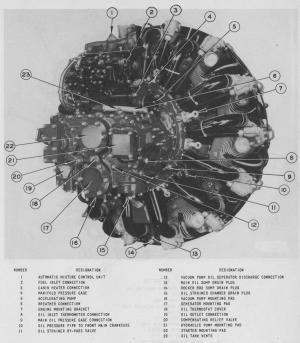 |
| Twin Wasp D |
Twin Wasp D |
Twin Wasp D |
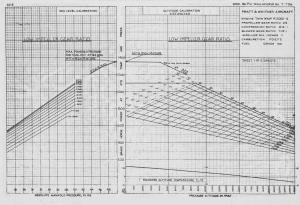 |
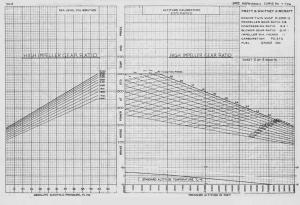 |
| Twin Wasp D Performance, Low Blower |
Twin Wasp D Performance, High Blower |





